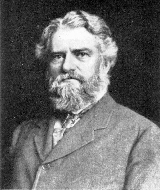History of the AA Department

Charles Henry Davis
In 1849, Congress established the Nautical Almanac Office to prepare and publish an official national almanac. Up to that time American scientists and seamen relied on foreign almanacs - particularly those of Great Britain - for astronomical and navigational data. Privately published almanacs, such as Benjamin Franklin's Poor Richard's Almanac, were generally not adequate for scientific use. The Office was placed under the direction of Lieutenant Charles Henry Davis, an experienced naval officer with a scientific background and personal associations with prominent American scientists. Davis established the Office in Cambridge, Massachusetts, independent of the U.S. Naval Observatory in Washington. In Cambridge the Office had access to Harvard University and Professor Benjamin Peirce, the leading American mathematician of the time. The Office would remain in Cambridge until 1866, when it was moved to Washington, DC. In 1893, the Nautical Almanac Office moved into office space at the U.S. Naval Observatory's new home north of Georgetown.
Davis and Peirce immediately began surveying the sources of accurate astronomical data. Although American scientists wanted to produce a work of purely American science, Davis found it necessary to use theories and data developed in Europe. The new staff began calculating positions of the Sun, Moon and planets. This had to be done entirely by hand, by human "computers" who carefully checked each other's work. The size of the job was enormous. It was reported that if two computers were assigned to calculate the position of the Moon for noon and midnight, they could complete and check one full set of calculations during a work day. In other words, they could just keep up with the Moon.
In 1852, the Office published its first volume, The American Ephemeris and Nautical Almanac for 1855. An extract of this, The American Nautical Almanac for 1855, was issued for mariners. The American Ephemeris and Nautical Almanac provided data needed by astronomers and surveyors. In addition to its practical purpose, it served as a source of national pride. The volume was regarded as an important demonstration of the developing scientific prowess in the United States.
A number of members of the Almanac Office took the opportunity to study at Harvard. There they acquired a thorough grounding in mathematical astronomy that would make the Office an important center of astronomical research. From the beginning it was realized that the formulas used to calculate lunar and planetary positions were far from perfect. Although Isaac Newton had presented his law of gravitation nearly two centuries before, the mathematical problems it presented were far from solved. Comparison of calculated positions with observations - particularly of the Moon - revealed that the formulas would need to be upgraded.

Simon Newcomb
Simon Newcomb, a "computer" who studied at Harvard, became Superintendent of the Office in 1877. He had already conceived a vigorous research program that would lead to new theoretical models for the orbits of the Moon and all the planets. For the first time, the orbital models were to be based on consistent theoretical methods and observational data. In carrying out this program, Newcomb became one of the most famous scientists in America and raised the Nautical Almanac Office to its highest level of eminence.
Newcomb was fortunate in having on his staff the highly respected mathematician G.W. Hill. With the help of computing assistants, Newcomb worked on the Moon and the planets Mercury, Venus, Earth, Mars, Uranus and Neptune. Hill, working alone, undertook the extremely difficult theories of Jupiter and Saturn. In addition Hill carried on his own study of the Moon's motion. By the end of the century, they had developed a new set of theories for all the known planets. These theories were good enough to be used at least to 1960. In fact, Newcomb's theories for the motions of Mercury, Venus, Earth and Mars were used up to 1984.
Following Newcomb's retirement in 1897, the Office reduced the scope of its research efforts. The Newcomb/Hill theories had to be implemented in the annual almanacs, and there was increased concern with navigation. Efforts turned to improving The American Nautical Almanac. The almanac for 1916 introduced a new format that greatly increased its utility for navigators. In the 1930s there were additional improvements. Then in 1950, the volume underwent a major redesign. In 1960 there were further revisions and the title was changed to The Nautical Almanac.
In the late 1920s, there was interest in producing a volume to aid navigation of aircraft. After publication of a few Aeronautical Supplements, an experimental American Air Almanac was produced for 1933. Then beginning with 1941, The American Air Almanac became an annual publication. Renamed The Air Almanac in 1953, the volume continues to be published.
Active cooperation among the national almanac offices started at the International Congress on Astronomical Ephemerides held at Paris Observatory in October 1911. Its comprehensive recommendations covered the distribution of calculations among the five principal almanac offices of the day (France, Germany, Great Britain, Spain, and the United States), specified standards of calculation and presentation, arranged for publication of additional data, and fixed the values of two constants to be used in the ephemerides. A common language especially facilitated cooperation between the American and British offices, which ultimately resulted in the unification of the two countries' almanacs.

Wallace Eckert
The next scientific watershed came in 1940 with the appointment of Wallace J. Eckert as Director of the Nautical Almanac Office. His background included expertise with newly developed equipment for tabulating and sorting punched cards. This was the beginning of electronic computers. Eckert initially applied the new equipment to production of The Air Almanac, enabling the volume to be produced efficiently and free of typesetting errors.
As computers developed, larger computing projects became possible. An important example is the calculation of improved orbits for Jupiter, Saturn, Uranus, Neptune and Pluto. This project, completed in 1950, was a cooperative effort of the Nautical Almanac Office, IBM and Yale University. Cooperation with Yale would continue through the 1960s, with several members of the Office going there for graduate studies.

Raynor Duncombe
In the 1960s, under the direction Raynor L. Duncombe, who studied at Yale, members of the Office undertook a new series of research efforts. Duncombe pursued cooperative ventures with a variety of institutions. Close cooperation developed with Her Majesty's Nautical Almanac Office in Great Britain and with scientists at the Jet Propulsion Laboratory. While the British and American Almanac Offices had long communicated about scientific issues, their efforts had become unnecessarily redundant. In the 1970s, JPL made use of high precision radar, laser and spacecraft observations to develop a complete new set of orbital calculations for the Moon and planets. These were introduced in The Astronomical Almanac (a new, joint publication of the British and American offices) for 1984.
In the 1970s the Nautical Almanac Office began exploring means for presenting astronomical data in computerized formats. The first effort was the Almanac for Computers, a publication presenting formulas and series approximations for the positions of celestial objects. It was published annually for the years 1977 through 1991. The Floppy Almanac, an almanac program for early personal computers, was produced for the years 1986 through 1996. By the late 1980s, evolving computer technology created the demand for a new computer almanac, easier to use than the Floppy Almanac and with more features. Design work began on what would become MICA, the Multiyear Interactive Computer Almanac. First released in 1993, MICA performs rigorous almanac calculations for user-specified locations and times, and also incorporates a full graphical user interface.
Relatively inexpensive desktop-publishing systems, introduced to the Nautical Almanac Office in the middle 1980s, revolutionized almanac production by enabling a local, direct pipeline from computations to camera-ready pages. These systems greatly reduced production time and simplified proofreading procedures.
In 1990, a reorganization at the Naval Observatory created two new departments, Astronomical Applications and Orbital Mechanics, to take on the tasks formerly performed by the Nautical Almanac Office. The Astronomical Applications Department was established to publish the almanacs and develop astronomical software products. The Orbital Mechanics Department was created to conduct celestial mechanics research. The Nautical Almanac Office, with a staff reduced by a factor of five, became a division within the Astronomical Applications Department whose sole responsibility was the preparation of the printed almanacs. In 1994, another reorganization abolished the Orbital Mechanics Department, and the Astronomical Applications Department acquired some of its staff and research activities.
During the 1990s and continuing into the next century, the Astronomical Applications Department began a series of projects aimed at modernizing the practice of celestial navigation, including development of new, rigorous algorithms for sight reduction. By the late 1990s, the department had established a presence on the Internet through a popular Web site that offered computational tools and astronomical information. In 2001, another Web site, The Astronomical Almanac Online, made its debut, offering almanac data that complemented and extended the material available in the printed book. The 2008 edition of The Air Almanac became the first almanac jointly produced by the U.S. and British offices to be available only on an electronic medium (CD-ROM).

